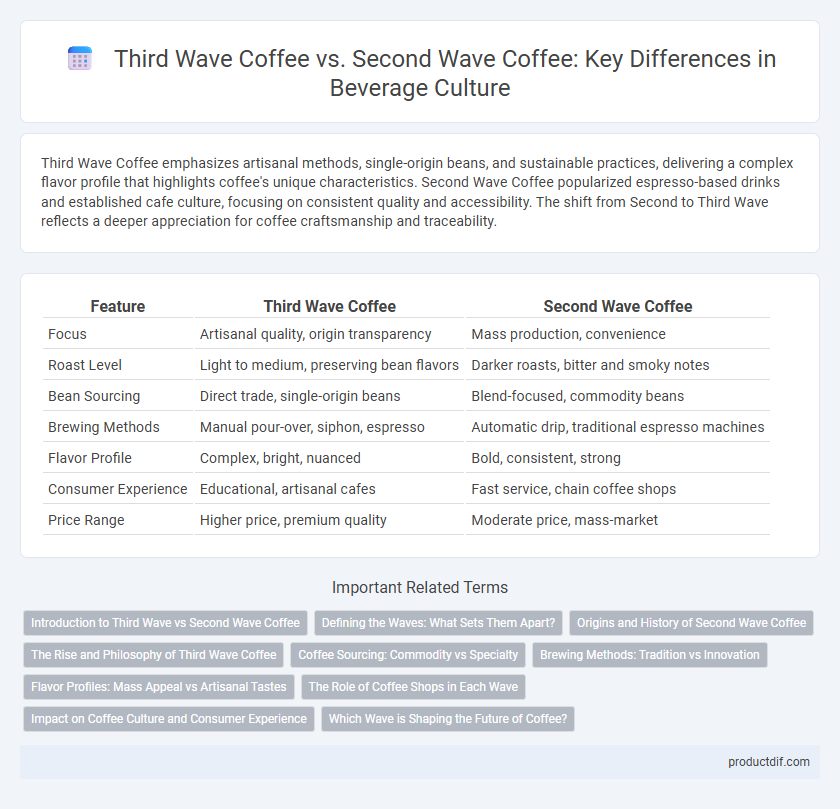Third Wave Coffee emphasizes artisanal methods, single-origin beans, and sustainable practices, delivering a complex flavor profile that highlights coffee's unique characteristics. Second Wave Coffee popularized espresso-based drinks and established cafe culture, focusing on consistent quality and accessibility. The shift from Second to Third Wave reflects a deeper appreciation for coffee craftsmanship and traceability.
Table of Comparison
| Feature | Third Wave Coffee | Second Wave Coffee |
|---|---|---|
| Focus | Artisanal quality, origin transparency | Mass production, convenience |
| Roast Level | Light to medium, preserving bean flavors | Darker roasts, bitter and smoky notes |
| Bean Sourcing | Direct trade, single-origin beans | Blend-focused, commodity beans |
| Brewing Methods | Manual pour-over, siphon, espresso | Automatic drip, traditional espresso machines |
| Flavor Profile | Complex, bright, nuanced | Bold, consistent, strong |
| Consumer Experience | Educational, artisanal cafes | Fast service, chain coffee shops |
| Price Range | Higher price, premium quality | Moderate price, mass-market |
Introduction to Third Wave vs Second Wave Coffee
Third Wave Coffee emphasizes artisanal quality, traceability, and sustainable sourcing, differentiating itself from Second Wave Coffee's focus on widespread accessibility and consistent flavor profiles typically found in major coffee chains. Third Wave Coffee prioritizes single-origin beans and precise brewing techniques to highlight the unique characteristics of each coffee variety. Second Wave Coffee popularized espresso-based drinks and introduced coffee culture as a social experience, setting foundational standards before the Third Wave movement deepened consumer awareness of coffee craftsmanship.
Defining the Waves: What Sets Them Apart?
Third Wave Coffee emphasizes single-origin beans, artisanal brewing methods, and a focus on coffee's unique flavor profiles, contrasting with Second Wave Coffee's emphasis on consistent taste, larger-scale production, and popularized espresso-based drinks. Second Wave Coffee brands like Starbucks introduced coffee as a daily lifestyle product, while Third Wave pioneers such as Stumptown and Blue Bottle prioritize transparency, sustainability, and direct trade relationships. This shift marks a move from commoditized coffee consumption to an appreciation of coffee as a craft and culinary experience.
Origins and History of Second Wave Coffee
Second Wave Coffee emerged in the 1960s and 1970s, driven by companies like Starbucks that introduced espresso-based drinks and emphasized consistent quality and cafe culture. This era marked a shift from simple coffee consumption to an appreciation for branded coffee experiences and specialty blends sourced primarily from Latin America. Unlike Third Wave Coffee, which focuses on artisanal, single-origin beans and sustainable farming, the Second Wave popularized mass-market specialty coffee with a focus on convenience and flavor consistency.
The Rise and Philosophy of Third Wave Coffee
Third Wave Coffee emphasizes artisanal craftsmanship, focusing on single-origin beans, precise brewing techniques, and sustainable sourcing to elevate coffee to a specialty beverage experience. This movement contrasts with Second Wave Coffee's emphasis on mass-market brands and consistent, standardized flavors, instead celebrating transparency and direct trade relationships with farmers. Third Wave Coffee prioritizes the unique flavor profile of each coffee bean, fostering an appreciation for quality and ethical production throughout the coffee supply chain.
Coffee Sourcing: Commodity vs Specialty
Third Wave Coffee emphasizes direct trade sourcing from specialty coffee farms, ensuring traceability, sustainable practices, and premium bean quality. Second Wave Coffee typically relies on commodity coffee purchased through large distributors, focusing on consistent flavor profiles rather than origin transparency. This shift in sourcing underlines Third Wave's commitment to elevating coffee as an artisanal product rather than a mass-produced commodity.
Brewing Methods: Tradition vs Innovation
Third Wave Coffee emphasizes precision and innovation in brewing methods, utilizing techniques like pour-over, siphon, and cold brew to extract nuanced flavors and highlight bean origin. Second Wave Coffee relies heavily on traditional methods such as drip brewing and espresso machines, focusing on consistency and mass appeal rather than experimental profiles. The shift from Second to Third Wave marks a transition from convenience-driven preparation to artisanal craftsmanship and flavor complexity in coffee brewing.
Flavor Profiles: Mass Appeal vs Artisanal Tastes
Second Wave Coffee emphasizes consistent, bold flavors designed for broad market appeal, featuring dark roasts with intense bitterness and caramelized notes. Third Wave Coffee celebrates unique, artisanal tastes by highlighting origin-specific flavors, bright acidity, and nuanced fruity or floral profiles from light to medium roasts. This shift prioritizes bean quality, single-origin sourcing, and meticulous brewing methods to enhance distinctive flavor complexity over mass-produced uniformity.
The Role of Coffee Shops in Each Wave
Third Wave Coffee shops emphasize artisanal brewing methods, single-origin beans, and customer education to highlight the unique flavors and ethical sourcing of coffee. In contrast, Second Wave Coffee shops focus on convenience, consistent flavor profiles, and building a cafe culture centered around espresso-based drinks and brand loyalty. The evolution from Second to Third Wave reflects a shift from commercialized coffee experiences to craftsmanship and transparency in the coffee industry.
Impact on Coffee Culture and Consumer Experience
Third Wave Coffee emphasizes artisanal, traceable beans and precise brewing techniques, elevating consumer appreciation for coffee's origin and flavor complexity. This movement fosters a culture of sustainability and education, promoting direct relationships between growers and consumers. In contrast, Second Wave Coffee popularized specialty blends and espresso-based drinks, making coffee culture more accessible but less focused on bean provenance and nuanced tasting experiences.
Which Wave is Shaping the Future of Coffee?
Third Wave Coffee is shaping the future of coffee by emphasizing artisanal quality, sustainability, and direct trade relationships with farmers, which enhances flavor complexity and ethical sourcing. Unlike Second Wave Coffee's focus on convenience and standardized taste, the Third Wave movement prioritizes single-origin beans, precise brewing techniques, and a deeper consumer appreciation for coffee craftsmanship. This shift towards transparency and quality-driven experiences is driving innovation and redefining industry standards for coffee lovers worldwide.
Third Wave Coffee vs Second Wave Coffee Infographic

 productdif.com
productdif.com